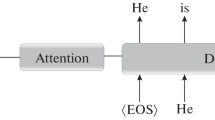Abstract
Tokenization or segmentation is a wide concept that covers simple processes such as separating punctuation from words, or more sophisticated processes such as applying morphological knowledge. Neural Machine Translation (NMT) requires a limited-size vocabulary for computational cost and enough examples to estimate word embeddings. Separating punctuation and splitting tokens into words or subwords has proven to be helpful to reduce vocabulary and increase the number of examples of each word, improving the translation quality. Tokenization is more challenging when dealing with languages with no separator between words. In order to assess the impact of the tokenization in the quality of the final translation on NMT, we experimented on five tokenizers over ten language pairs. We reached the conclusion that the tokenization significantly affects the final translation quality and that the best tokenizer differs for different language pairs.
Access this chapter
Tax calculation will be finalised at checkout
Purchases are for personal use only
Similar content being viewed by others
References
Bahdanau, D., Cho, K., Bengio, Y.: Neural machine translation by jointly learning to align and translate. arXiv preprint arXiv:1409.0473 (2015)
Britz, D., Goldie, A., Luong, T., Le, Q.: Massive exploration of neural machine translation architectures. arXiv preprint arXiv:1703.03906 (2017)
Dyer, C.: Using a maximum entropy model to build segmentation lattices for MT. In: Proceedings of the Annual Conference of the North American Chapter of the Association for Computational Linguistics, pp. 406–414 (2009)
Goldwater, S., McClosky, D.: Improving statistical MT through morphological analysis. In: Proceedings of the Conference on Human Language Technology and Empirical Methods in Natural Language Processing, pp. 676–683 (2005)
Hochreiter, S., Schmidhuber, J.: Long short-term memory. Neural Comput. 9(8), 1735–1780 (1997)
Huck, M., Riess, S., Fraser, A.: Target-side word segmentation strategies for neural machine translation. In: Proceedings of the Conference on Machine Translation, pp. 56–67 (2017)
Kingma, D.P., Ba, J.: Adam: a method for stochastic optimization. arXiv preprint arXiv:1412.6980 (2014)
Klein, G., Kim, Y., Deng, Y., Senellart, J., Rush, A.M.: OpenNMT: open-source toolkit for neural machine translation. arXiv preprint arXiv:1701.02810 (2017)
Koehn, P.: Statistical significance tests for machine translation evaluation. In: Proceedings of the Conference on Empirical Methods in Natural Language Processing, pp. 388–395 (2004)
Koehn, P., et al.: Moses: open source toolkit for statistical machine translation. In: Proceedings of the Annual Meeting of the Association for Computational Linguistics, pp. 177–180 (2007)
Kudo, T.: Sentencepiece experiments (2018). https://github.com/google/sentencepiece/blob/master/doc/experiments.md
Kudo, T.: Subword regularization: improving neural network translation models with multiple subword candidates. In: Proceedings of the Annual Meeting of the Association for Computational Linguistics, pp. 66–75 (2018)
Nguyen, T., Vogel, S., Smith, N.A.: Nonparametric word segmentation for machine translation. In: Proceedings of the International Conference on Computational Linguistics, pp. 815–823 (2010)
Nießen, S., Ney, H.: Statistical machine translation with scarce resources using morpho-syntactic information. Comput. Linguist. 30(2), 181–204 (2004)
Papineni, K., Roukos, S., Ward, T., Zhu, W.J.: BLEU: a method for automatic evaluation of machine translation. In: Proceedings of the Annual Meeting of the Association for Computational Linguistics, pp. 311–318 (2002)
Pascanu, R., Gulcehre, C., Cho, K., Bengio, Y.: How to construct deep recurrent neural networks. arXiv preprint arXiv:1312.6026 (2013)
Pinnis, M., Krišlauks, R., Deksne, D., Miks, T.: Neural machine translation for morphologically rich languages with improved sub-word units and synthetic data. In: Proceedings of the International Conference on Text, Speech, and Dialogue, pp. 237–245 (2017)
Schuster, M., Paliwal, K.K.: Bidirectional recurrent neural networks. IEEE Trans. Signal Process. 45(11), 2673–2681 (1997)
Sennrich, R., Haddow, B., Birch, A.: Neural machine translation of rare words with subword units. In: Proceedings of the Annual Meeting of the Association for Computational Linguistics, pp. 1715–1725 (2016)
Snover, M., Dorr, B., Schwartz, R., Micciulla, L., Makhoul, J.: A study of translation edit rate with targeted human annotation. In: Proceedings of the Association for Machine Translation in the Americas, pp. 223–231 (2006)
Sutskever, I., Vinyals, O., Le, Q.V.: Sequence to sequence learning with neural networks. In: Proceedings of the Advances in Neural Information Processing Systems, pp. 3104–3112 (2014)
Tseng, H., Chang, P., Andrew, G., Jurafsky, D., Manning, C.: A conditional random field word segmenter. In: Proceedings of the Special Interest Group of the Association for Computational Linguistics Workshop on Chinese Language Processing, pp. 168–171 (2005)
Wu, Y., et al.: Google’s neural machine translation system: bridging the gap between human and machine translation. arXiv preprint arXiv:1609.08144 (2016)
Zhao, H., Utiyama, M., Sumita, E., Lu, B.L.: An empirical study on word segmentation for Chinese machine translation. In: Proceedings of the Computational Linguistics and Intelligent Text Processing, pp. 248–263 (2013)
Acknowledgments
The research leading to these results has received funding from the Centro para el Desarrollo Tecnológico Industrial (CDTI) and the European Union through Programa Operativo de Crecimiento Inteligente (EXPEDIENT: IDI-20170964). We gratefully acknowledge the support of NVIDIA Corporation with the donation of a GPU used for part of this research.
Author information
Authors and Affiliations
Corresponding author
Editor information
Editors and Affiliations
Rights and permissions
Copyright information
© 2023 Springer Nature Switzerland AG
About this paper
Cite this paper
Domingo, M., García-Martínez, M., Helle, A., Casacuberta, F., Herranz, M. (2023). How Much Does Tokenization Affect Neural Machine Translation?. In: Gelbukh, A. (eds) Computational Linguistics and Intelligent Text Processing. CICLing 2019. Lecture Notes in Computer Science, vol 13451. Springer, Cham. https://doi.org/10.1007/978-3-031-24337-0_38
Download citation
DOI: https://doi.org/10.1007/978-3-031-24337-0_38
Published:
Publisher Name: Springer, Cham
Print ISBN: 978-3-031-24336-3
Online ISBN: 978-3-031-24337-0
eBook Packages: Computer ScienceComputer Science (R0)




